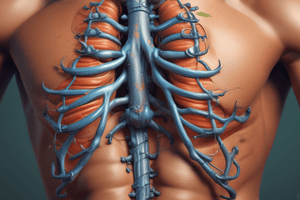Podcast
Questions and Answers
The safe working load (SWL) for rope uses a factor of five as a safety margin.
The safe working load (SWL) for rope uses a factor of five as a safety margin.
False (B)
Tensile Strength measures the ability of a rope to withstand force applied quickly.
Tensile Strength measures the ability of a rope to withstand force applied quickly.
False (B)
Breaking Strength indicates the weight or force that can safely be applied to a rope.
Breaking Strength indicates the weight or force that can safely be applied to a rope.
False (B)
The safety factor accounts for increased strength of the rope under operating conditions.
The safety factor accounts for increased strength of the rope under operating conditions.
Lead climbing techniques are discussed in detail in the training manual and program.
Lead climbing techniques are discussed in detail in the training manual and program.
Consulting the specific rope manufacturer is necessary to determine the Safe Working Load (SWL).
Consulting the specific rope manufacturer is necessary to determine the Safe Working Load (SWL).
Prusik Rope is primarily used for cutting through ropes during rescue operations.
Prusik Rope is primarily used for cutting through ropes during rescue operations.
It is recommended to wash ropes in a washing machine without proper chaining and suitable washing product.
It is recommended to wash ropes in a washing machine without proper chaining and suitable washing product.
Twisting and kinking ropes are encouraged for better durability.
Twisting and kinking ropes are encouraged for better durability.
Ropes should not be exposed to direct sunlight during storage.
Ropes should not be exposed to direct sunlight during storage.
It is safe to smoke around ropes and rigging equipment during rescue operations.
It is safe to smoke around ropes and rigging equipment during rescue operations.
Retirement of rope is recommended after being in service for ten years.
Retirement of rope is recommended after being in service for ten years.
Using a tree with a diameter of less than 25 cm is recommended when selecting it as an anchor.
Using a tree with a diameter of less than 25 cm is recommended when selecting it as an anchor.
Rocky outcrops and boulders are not suitable to be used as anchors due to their instability.
Rocky outcrops and boulders are not suitable to be used as anchors due to their instability.
It is important to avoid sharp edges when using rocky outcrops or boulders as anchors.
It is important to avoid sharp edges when using rocky outcrops or boulders as anchors.
It is advisable to attach webbing or rope directly to a tree without checking for potential damage to the anchoring material.
It is advisable to attach webbing or rope directly to a tree without checking for potential damage to the anchoring material.
Large trees are not suitable to be used as anchors because they are often rotted.
Large trees are not suitable to be used as anchors because they are often rotted.
Boulders sitting on smaller rocks can provide a stable anchor due to the increased friction between the rocks.
Boulders sitting on smaller rocks can provide a stable anchor due to the increased friction between the rocks.
In a compound pulley system with different Mas, the system with the higher MA should be attached to the load.
In a compound pulley system with different Mas, the system with the higher MA should be attached to the load.
Z-Rigs have a 2:1 Mechanical Advantage.
Z-Rigs have a 2:1 Mechanical Advantage.
Complex Mechanical Advantage Systems require more equipment compared to simple systems.
Complex Mechanical Advantage Systems require more equipment compared to simple systems.
A Change of Direction (COD) within a Mechanical Advantage is when pulling force and load travel in the same direction.
A Change of Direction (COD) within a Mechanical Advantage is when pulling force and load travel in the same direction.
Separate anchors are not necessary for each Mechanical Advantage system in complex setups.
Separate anchors are not necessary for each Mechanical Advantage system in complex setups.
Z-Rigs are only used in simple rope rescue systems.
Z-Rigs are only used in simple rope rescue systems.
The Radium Release Hitch allows for two prusiks to work without interfering with each other.
The Radium Release Hitch allows for two prusiks to work without interfering with each other.
A Prusik Minding Pulley (PMP) is essential for a lowering operation.
A Prusik Minding Pulley (PMP) is essential for a lowering operation.
The shorter prusik in a Prusik Safety Belay should be closer to the load release connection.
The shorter prusik in a Prusik Safety Belay should be closer to the load release connection.
Rappelling involves ascending a rope using a descent control device.
Rappelling involves ascending a rope using a descent control device.
Most rescue teams use a personal brake bar or micro rack as a descending device during rappelling.
Most rescue teams use a personal brake bar or micro rack as a descending device during rappelling.
The descending device is connected to the rescuer's harness using an unlocked carabiner.
The descending device is connected to the rescuer's harness using an unlocked carabiner.
Flashcards are hidden until you start studying




